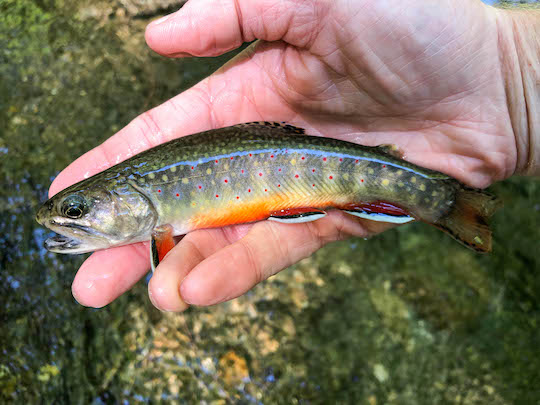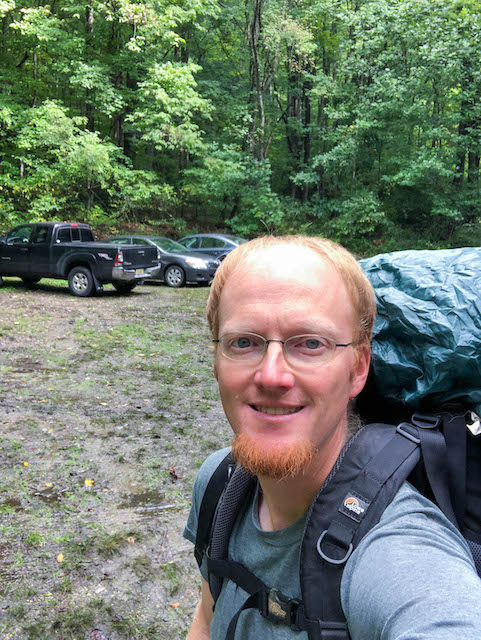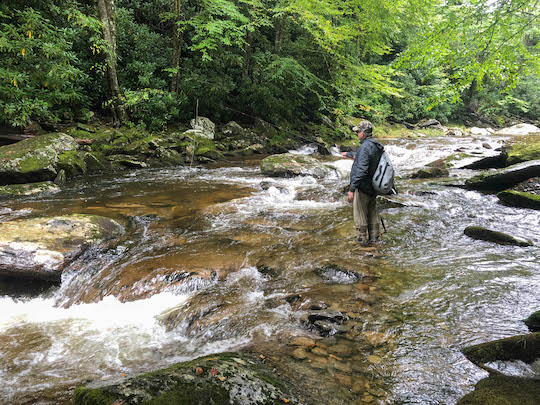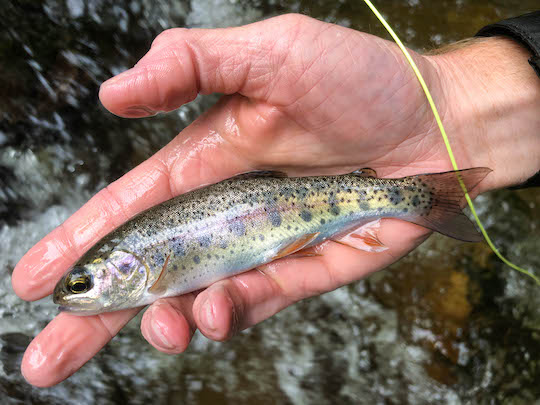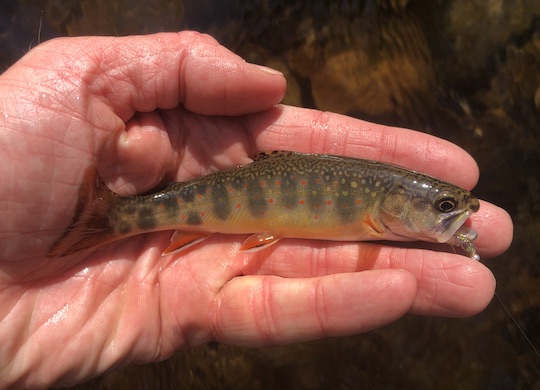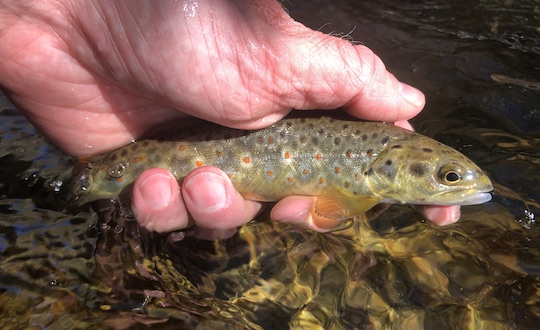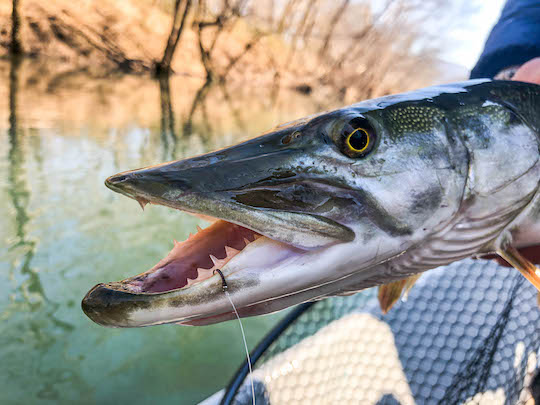This was a hiking day that I had been looking forward to more than almost any other on our trip. However, it was not just excitement. A small element of trepidation had also snuck in. So why was I feeling so conflicted about this hike?
Preparing for Our Hike to Loch Vale, Lake of Glass, and Sky Pond
First, you should know that this is a hike I have wanted to do for a long time. While I should have knocked it out when I actually lived an hour away, those days are long gone, and you can't live on shoulda coulda. Fast forward to early 2022 when I first floated the idea of a Colorado trip to my wife. As I was researching different hikes to include on our trip, this one just seemed like a natural fit. Based on our prior adventures in Glacier National Park, I knew that some longer high elevation hikes were ideal for us. This is the type of hiking we love and largely why we enjoy traveling. Even for local hikes, we are just as likely to knock out a bunch of miles as we are to go for a short stroll. But, and this was the important part, the elevation difference between Glacier and Rocky Mountain National Park was significant.
In Glacier, our highest hike was just over 8,000 feet above sea level while this particular hike in Colorado would start out above 9,000 feet and end just a touch shy of 11,000 feet above sea level. Leah had dealt with elevation sickness at the Medicine Wheel and this hike would get significantly higher than that. I had previously dealt with it as well at high altitude in Colorado some years ago on multiple occasions. On each occasion for both of us, the main common denominator had been that we had tried hiking at altitude too soon after arriving from the lowlands of the eastern US. As this was precisely what we would be doing on this trip, I was a little nervous. Oh, and did I mention I would be carrying a one year old and everything else that goes along with a baby, plus my camera, water and some Tenkara equipment?
The actual distance didn't worry us. I've lugged the toddler around in her pack out to 15 or so miles. While tired afterwards, I could have gone more no problem. We have done 20 mile days, so something half of that or less isn't bad at all. The thin air would be our primary nemesis. Living on the Cumberland Plateau of Tennessee is slightly better than sea level, but we are still just a touch over 1,800 feet in elevation, much too low to have any benefit once we hit the Colorado Rocky Mountains. The absolute highest elevation hikes we can do in the Smokies are still essentially like hiking in the foothills in Colorado. When I say foothills, I mean at the foot of the foothills or nearly so.
Before our trip, we had both put in a little extra effort. This mostly involved doing everything in our power to boost our cardiovascular capacity. That is, we did some running, including mixing in at least a little interval training, and I had been backpacking on my now annual brook trout trip. Of course, we also spent some time out on the trails around home, particularly carrying the toddler around on my back at least occasionally to get my body used to the abuse. Thus, we were about as prepared as could be considering that we literally arrived in Colorado and then immediately headed out on one of the hardest hikes of our entire trip. In the end, that might have actually been a good idea for more reasons than we would realize for a while.
The Morning of Our Hike to Loch Vale, Lake of Glass, and Sky Pond
Fast forward just a bit and we are in Colorado. We woke up to an absolutely perfect day. Knowing the chance of foul weather would sneak up on us the next day, we were intent on making the most of this day. After all, these big hikes are always the highlight of any trip we do. The sun was warm and the air promised a perfect day. I had to snap a quick picture of our Big Agnes tent nestled amongst the pines at the Moraine Park campground where we camped for our first three nights on this trip.
 |
| "Camping in our Big Agnes Tent in Moraine Park Campground" ©2022 David Knapp Photography |
I think we had slightly underestimated the amount of work that it would be to care for a toddler on an extended camping trip. However, on this day, we mostly got going smoothly. Not quite early enough, unfortunately, but early enough to get this hike done during daylight hours. As with most particularly scenic and well known National Park, Rocky Mountain National Park has a problem of being loved to death. On the east side of the Park, this manifests itself as jam packed parking lots, much the same as we experienced in Glacier National Park. Thankfully, with COVID becoming more and more a thing of the past, the National Park Service operated hiker shuttle was operating. Once we determined that there was no parking at the Glacier Gorge trailhead, we quickly headed back down to the Park and Ride to have breakfast (a tradition we started in Glacier) and get ready for our hike.
The routine we established in Glacier National Park again served us well, although since we ended up on the shuttle it was probably not necessary. This ended up being the only time we used this routine on the Colorado trip, but for reasons you'll find out more on later. We had breakfast at our car at the Park and Ride and also fixed our lunch sandwiches and packed our backpacks. For me, that meant a DSLR camera, Tenkara gear, baby diapers, wipes, and a change of clothes, water, water filter, and a few "emergency" type items such as a couple of ways to start fire, bandaids, ace bandage, and don't forget some extra bags for carrying dirty diapers. Thankfully, my wife agreed to carry my lunch in addition to hers and the baby's since I would be carrying the little one.
Once all of these tasks were complete and we changed diapers a time or two, we finally boarded the shuttle bus and headed up the mountain towards the Glacier Gorge trailhead.
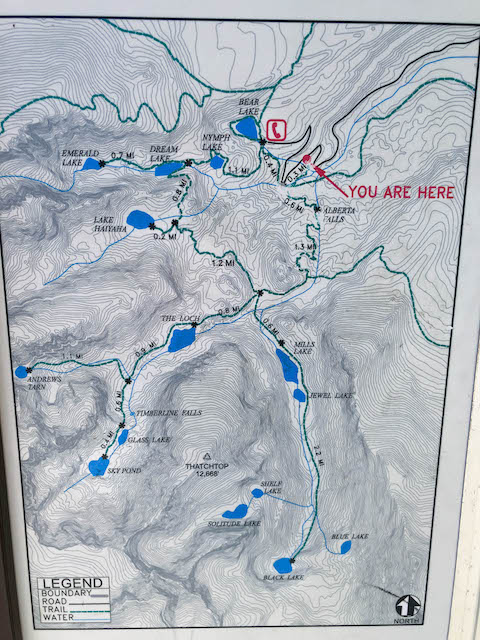 |
| "Glacier Gorge trailhead map" ©2022 David Knapp Photography |
Hiking to Alberta Falls From the Glacier Gorge Trailhead
A bonus on this hike to Sky Pond would be catching a glimpse of Alberta Falls. This beautiful waterfall is right alongside the trail and impossible to miss.
Timing for our trip largely centered around what we hoped would be a good amount of fall foliage. On this day, we started seeing some early signs of fall with plenty of golden aspen, but most trees were still either green or just barely starting to turn. We snapped a few pictures while we hiked, but mostly just kept our heads down and cranked out the miles. We hoped to eat lunch up at one of the high lakes that were our main goals for the hike.
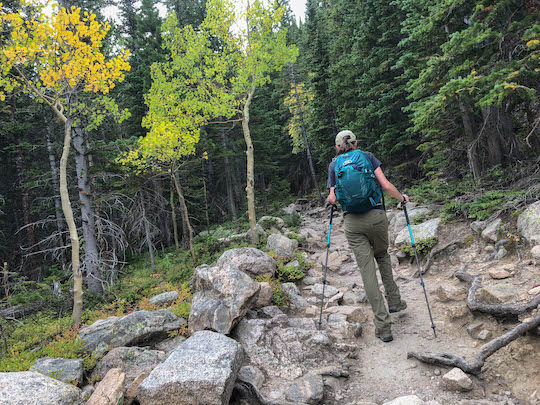 |
| "Hiking the Trail to Loch Vale in Rocky Mountain National Park" ©2022 David Knapp Photography |
Alberta Falls was gorgeous, but the lighting was simply never good when we happened to be hiking by. With a heavy toddler that was starting to feel even chunkier than I remembered, keeping our rhythm hiking was more important than forcing some shots that I knew wouldn't turn out the way I wanted. Many people appeared to be stopping at the falls. We were just getting warmed up and set our sights higher.
Hiking to Loch Vale from Glacier Gorge Trailhead
The hike to Loch Vale (also known as The Loch) is fairly simple overall. There was really only one steeper section of switchbacks not too far below the lake itself. We made good time up to this point with the baby thankfully taking a morning nap. We enjoyed the occasional yellow aspen and kept cranking out the steps. If you start at the Glacier Gorge Trailhead as we did, it is between 2.5 and 3 miles to Loch Vale. While the trail is well travelled, it is still an easy trail if you ask me.
Thankfully we got there in good time and were able to relax, take pictures, let the little one down to run around and play, and of course, I got to do some fishing! I'll cover the fishing part later in this blog, but when we first came up to the lake, I saw fish everywhere which is always a good sign.
 |
| "Rising Trout" ©2022 David Knapp Photography |
The scenery was the main draw of this hike and Loch Vale did not disappoint. Lying in a basin with two lakes up higher near the divide, we enjoyed the views and the sun was out as well. It was nice and warm. Little did we know that this would be one of the last truly warm days we would experience on the trip. All of us enjoyed this stop immensely! Notice the nice clear blue skies...
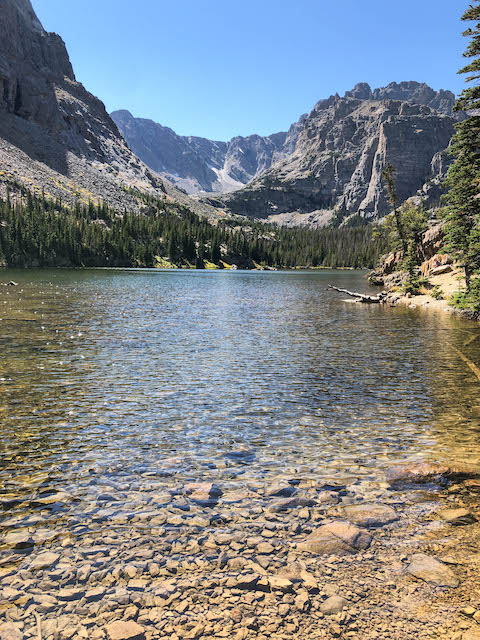 |
| "Loch Vale in Rocky Mountain National Park" ©2022 David Knapp Photography |
Looking up the lake, you can see the higher basin above that continues another couple of lakes. The forbidding nearly vertical rock wall that separates you from these lakes is quite the scramble as we would find out shortly. While we were enjoying all of this, little bit was enjoying exploring and playing in the dirt. In fact, I think playing in the dirt was the highlight of the trip for her. At minimum, she made plenty of time every day to do so and we had quite the challenge on our hands to try and keep her semi clean.
 |
| "Why enjoy the scenery when you can play in the dirt?" ©2022 Leah Knapp Photography |
After a good break that also allowed time to filter some water (a filter is much lighter than 4 liters of water!), we were ready to continue on our hike. The trail follows the edge of Loch Vale all the way up to the inlet stream where it begins to slowly climb again. The inlet stream was FULL of fish as well. I was seriously wishing we had started just a little earlier, but at this point we needed to keep moving to finish before it was too late. My goal was to fish each of the lakes, and I would only accomplish this if we stayed more or less on schedule.
Continuing On To Lake of Glass in Rocky Mountain National Park
The trail beyond Loch Vale continues upward, gently at first through a beautiful evergreen forest alongside a babbling brook. Icy Brook begins high in this drainage and feeds through each lake in turn. After initially being a gentle climb, the trail began to get steeper around the trail junction for Andrews Glacier. We didn't have time to climb up to that point on this day, so we continued on towards Lake of Glass.
Shortly beyond the trail split, the climb increased significantly. We soon emerged from the forest into increasingly open terrain as we were closing in on treelined. This portion of the hike was easily the most intense as far as the climb goes. Ahead, we could see the bulk of rock that we had seen from Loch Vale. Up close, we could see Timberline Falls cascading down approximately 100 feet and the trail seemingly disappeared into the rock wall to the right of the falls.
This was the make or break part of our hike. Having done some rock climbing in the past, I wasn't too worried about moving up and over the rock. Having a baby on my back would make me significantly slower and more cautious though. Leah had a slightly different perspective. In fact, I think each time the story is told she reports being slightly more frightened. If this story is told another few years, she'll probably be scared to death during this climb. She is not a fan of heights, so this part was one of the most challenging things she has ever done on any of our hikes. The situation was made worse because I couldn't help her much. Instead, I had to make sure I got the baby safely up the steep climb. Thankfully, we were soon up. The view looking back down towards Loch Vale was impressive. Do you see Loch Vale here?
 |
| "Looking Down To Loch Vale From Timberline Falls" ©2022 David Knapp Photography |
We didn't linger at this view for long. I was hungry and Leah was hungry, so you know for sure that someone else was hungry. We quickly made our way up the last short climb to the Lake of Glass. On this day, we didn't see how in the world it had gotten that name. I think it would be amazing to be here when it is perfectly calm. The reflection of the surrounding mountains would be incredible. Still, the views were amazing even if the lake was a little choppy from the wind. Note the blue sky but with a hint of clouds just over the top of the ridge.
 |
| "Lake of Glass in Rocky Mountain National Park" ©2022 David Knapp Photography |
We wanted to eat lunch. The wind was worse than it looks in this picture and we hoped to find some semblance of shelter. We turned to the left and crossed the lake's outlet to get into the semi shelter of a large rock outcropping along the left shore of the lake. Here, we got our packs off, the little one out to play and eat, and of course, I grabbed my fishing gear again. Our lunch spot view was perfect.
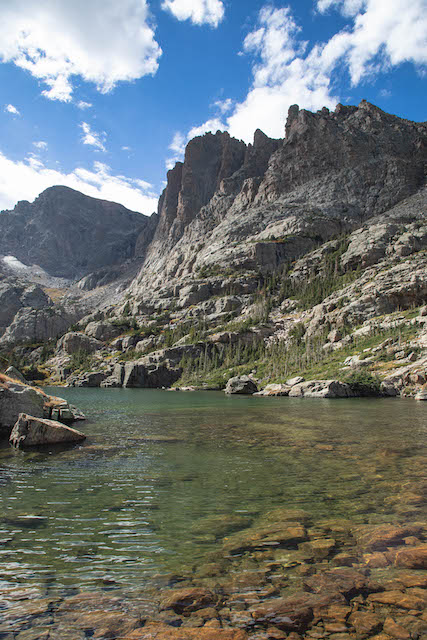 |
"Lunch with a few on Lake of Glass" ©2022 David Knapp Photography
|
Not long after this picture was taken, the clouds snuck over the ridge and the warm sun was gone just like that. We were thankful that we had enjoyed lunch with such nice conditions, but knew that we better hurry if we wanted to make it the last half mile or so to Sky Pond. The weather was clearly beginning to shift, and it doesn't pay to take the weather lightly at this high elevation.
Finally, Sky Pond!
So, why hike all the way to Sky Pond? First of all, this is the last lake as you go up this particular gorge/basin. Sitting immediately below the peaks, it is an incredibly impressive setting. Second, if you have already climbed Timberline Falls, you have done all of the hard work. Since we were at Lake of Glass, it made sense to hike the last short distance onwards to Sky Pond.
I could easily say this whole hike was a hike to Sky Pond, but ultimately it is three different hikes to three different lakes that just happen to all be on the same route. Each lake is unique and beautiful enough to be a destination on its own. We were blessed to be able to snag three of these lakes on one trip.
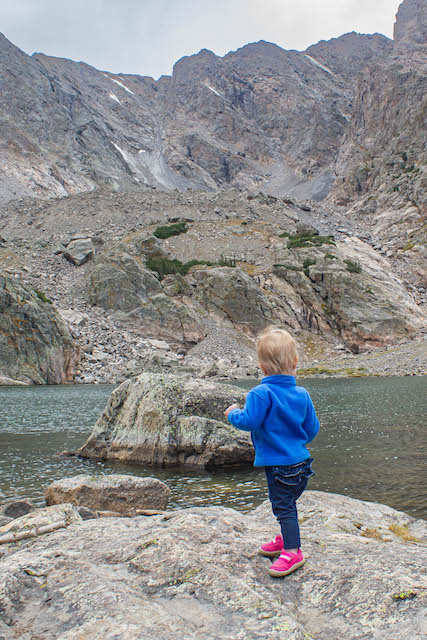 |
| "Little Bit looking over her domains at Sky Pond" ©2022 Leah Knapp Photography |
As an angler, the fishing was one of the main draws for me at Sky Pond as you'll see in a bit. Still, the fishing wasn't such a draw that I forgot to take some pictures. I didn't have my tripod with me to do things right, but I did take enough pictures to stitch together a reasonably decent panorama of the lake with the Sharkstooth on the right.
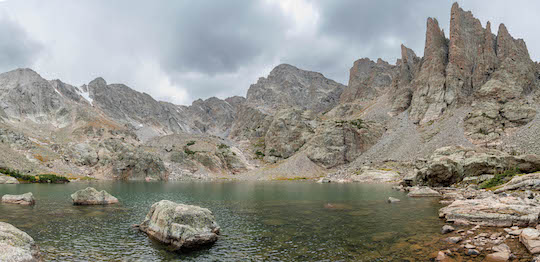 |
| "Sky Pond and the Sharkstooth" ©2022 David Knapp Photography |
Notice the dramatic clouds that were swirling above the massive cliffs above the lake. We had a significant weather system due into the area overnight, and it was obvious that the leading edge was already approaching. We needed to finish enjoying Sky Pond and then start hiking down before any rain (or snow?!?!) caught up with us.
Fishing at Loch Vale, Lake of Glass, and Sky Pond in Rocky Mountain National Park
Of course, this post wouldn't be complete without mentioning the fishing or the fact that I caught fish at each lake. The cutthroat trout at Loch Vale were the most beautiful fish I caught on this hike, but the other lakes produced some memorable moments as well.
When we first arrived at Loch Vale, I saw fish cruising everywhere. Of course, by the time I got my Tenkara rod out and rigged, they had seemingly disappeared. Never fear, however, because with cruising fish it won't be long before some more fish come along.
I was using my Tenkara USA Rhodo. This is an excellent packable rod option when I want different lengths that the rod can fish at. Most importantly, it was the lightest option since I was hauling a toddler on my back with all my other gear. I still don't know what I would have done with an actual fly rod. There were times on this hike that I wished for a full fly rod, but this wasn't specifically a fishing trip. I would more than gladly take whatever fishing I could scrounge up.
While a couple of fish quickly came over to look at my Parachute Adams, it quickly become apparent that they were too smart to eat it. Before long, I went to a small midge under the surface and that proved to be the ticket. For the rest of the entire trip, small midges or pheasant tails caught fish in mountain lakes when nothing else was working. I caught a few on dry flies from time to time as well, but definitely more and better fish subsurface.
After a fish or two, I was ready to put my gear away and head to the next lake. As I mentioned above, we were on a bit of a schedule, and that didn't allow for lingering too long with my rod to catch more fish. Here is one of the Loch Vale cutthroat. Talk about a beautiful fish!
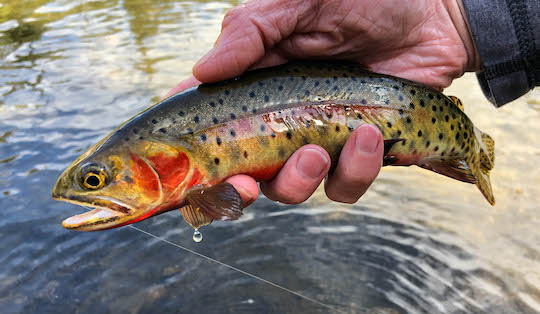 |
| "Cutthroat trout at Loch Vale" ©2022 David Knapp Photography |
And another angle...I just couldn't get enough of those beautiful red cheeks!
 |
| "Another perspective of a native cutthroat trout at The Loch" ©2022 David Knapp Photography |
Of course, I need some type of proof that I was really the one fishing and catching these fish! Thanks to my lovely wife Leah for running over to snap a picture or two in between wrangling a baby and taking pictures of her own.
 |
| "Happy angler at Loch Vale" ©2022 Leah Knapp Photography |
Not long after this picture, I was reminded that we probably should be moving on. I could have sat at this little spot all day trying to catch the beautiful cutthroat trout that swam in The Loch, but we had bigger goals for the day. We were soon packed and heading up the trail towards our next goal at Lake of Glass.
This was probably my shortest fishing experiment of the day. Lake of Glass was a great lunch spot, and I took at least a few moments to fish, but in between chasing a toddler over the landscape and eating, there just wasn't much time to fish. Thankfully, I met my goal of catching at least a fish at each lake. The cutthroat here were beautiful, but very different in coloration from their relatives below. My Tenkara rod continued to be the perfect solution that I could put together or break down in seconds. That meant more fishing time for me.
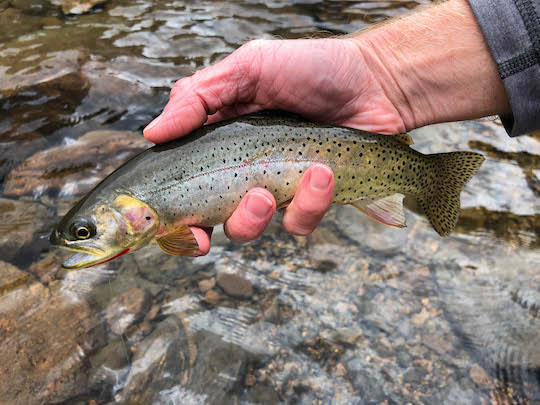 |
| "Cutthroat trout caught at Lake of Glass" ©2022 David Knapp Photography |
The neat part about this fish in particular is that I got it on the dry fly. In fact, there was a small hatch coming off. I saw some smaller dark stoneflies plus some mayflies that I didn't get a good look at. The fish were rising every time the wind died down a little. Our little corner of the lake was just sheltered enough to see fish coming to the surface every few minutes. It gave me hope for catching brook trout on dry flies at Sky Pond. Supposedly Lake of Glass has some brook trout as well, but all I caught here were cutthroat trout.
Sky Pond, on the other hand, only has brook trout from what I have gathered. That was definitely my experience. There are some really nice fish in this lake as well. I had the first issue with losing fish on the Tenkara rod here at Sky Pond. The light tippet I was using just didn't hold up to the ferocious hits the brook trout were producing. Finally, however, I got one to eat and stay hooked long enough to land. These high elevation brook trout are mighty hunters. Check out the mouth on this guy!
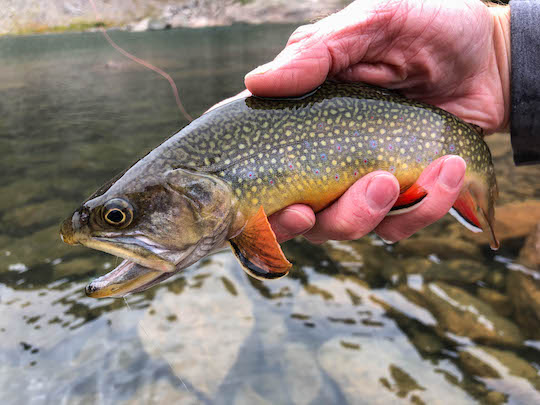 |
| "Brook trout at Sky Pond in Rocky Mountain National Park" ©2022 David Knapp Photography |
Perhaps the best part of fishing at Sky Pond is that the little one had been watching me the whole time, taking it all in. Eventually, she came over and wanted to climb into my lap from where she proceeded to take over the operation of the Tenkara rod. As it turns out, she was a natural caster, but didn't have the patience to leave the flies on the water long enough to catch anything. She loved the casting. It kept her occupied, and I'm not sure she really understood that there was more to it than casting.
 |
| "Teaching the next generation to fly fish at Sky Pond" ©2022 Leah Knapp Photography |
Hiking Back Down From Sky Pond
Shortly after this, with the clouds getting darker and darker, we turned around and headed back down the trail. By now, you have probably noticed something that is noticeably absent. For all my worry about elevation sickness, we were doing great. Thankfully we never ended up dealing with this problem at all on our trip. As it turns out, we had done sufficient preparation to avoid the problem altogether other than just getting tired from the long hikes at high elevation.
Hiking back down was mostly routine with one notable exception. As we approached the big drop alongside Timberline Falls, my foot slipped a little on one of the wet rocks. Knowing that this was a warning, I decided to take things very slowly. Going down is always harder to me than going up, and this was doubly so with a heavy pack that had to get down the mountain in one piece with me.
We worked our way carefully down, but finally reached a narrow ledge that requires a 4-5 foot drop to get to the next level near the bottom. I was trying to figure out how to get down without getting pushed off by the pack. Thankfully, at just the right moment, another group of hikers overtook us. I think they were wanting to go faster, but they were super gracious about the whole thing. In fact, the guy in the lead worked his way down the water course to our right and was soon below me where he offered to let me pass the little one down to him in the pack. It couldn't have been offered at a better time. Poor Leah was even more nervous than she was going up, so it enabled me to jump down, help her, and then get the baby carrier back on without risking the baby.
After getting below this drop, we really cruised. Our normal hiking speed, even with the kid carrier and a toddler, is usually somewhere around 3 miles an hour and level ground and often even more. In other words, it didn't take us too long to get back down. Sky Pond is probably 4.5 miles from the trailhead. With the extra looking around we did, we were still stretching it to get to 10 miles on the day.
The downhill miles flew by, and soon we were back waiting on the shuttle bus. It didn't take more than a few minutes before a bus stopped, and we were soon headed back to our car. From there, it was just a few more minutes down to our camp at Moraine Park. By this time, the weather was really starting to threaten, so we hurried with supper and got in our tent before the rain really got going. The next day would be damp, however. And thus would begin a trend that would just get stronger throughout our trip...




















